Two days ago I was delighted to photograph my first Peregrine Falcon of the year.
1/4000, f/8, ISO 250, Canon 7D Mark II, Canon EF 500mm f/4L IS II USM, not baited, set up or called in
I like the natural rock perch and the snowy setting but the lighting was a challenge. The bird was side-lit but because of the snow on the ground the images weren’t as contrasty as they could have been. Reflected light from the snow lit up many of the shaded parts of the bird reasonably well.
1/3200, f/8, ISO 200, Canon 7D Mark II, Canon EF 500mm f/4L IS II USM, not baited, set up or called in
This bird was unusually “sticky” for a peregrine and I suspect the cold had a lot to do with that because it was only 8° F. when these photos were taken. I spent quite a while with it but in that entire time the only thing the bird moved was its head. So when another car pulled up much too close to the falcon for comfort I figured it might spook so I tried to be ready for takeoff shots. I had already removed my teleconverter in preparation for that possibility.
1/3200, f/8, ISO 200, Canon 7D Mark II, Canon EF 500mm f/4L IS II USM, not baited, set up or called in
Falcons typically launch very quickly and it’s extremely easy to completely miss the takeoff so I tensely kept my finger on the half-depressed shutter button and watched for any sign of movement. When I saw the right foot begin to come down from its warm resting place in the belly feathers I fired off a quick burst and hoped for the best.
That foot movement was the beginning of a quick, fluid and continuous motion to take off.
1/4000, f/8, ISO 200, Canon 7D Mark II, Canon EF 500mm f/4L IS II USM, not baited, set up or called in
By the time my shutter clicked again (1/10 sec later) the falcon had twisted on the perch and started to raise its wings. Here the tail hasn’t even had time to follow the body so it’s still hidden behind the rump and wing.
1/2000, f/8, ISO 200, Canon 7D Mark II, Canon EF 500mm f/4L IS II USM, not baited, set up or called in
And in the next shot the falcon had already turned its head away in the direction it intended to fly. Because the tail and the head are out of the plane of focus they’re both soft. But I was still glad to get this shot for two reasons – it confirmed that the bird actually did have a tail 🙂 and it also confirmed that there were no bands or jesses on the falcon. Twice before I’ve photographed Peregrine Falcons with falconry paraphernalia still on their legs. Those birds had obviously escaped from their “owners”.
As hard as I tried my strategy for attempting to get a spectacular take off shot or two didn’t work out this time.
But next time it just might…
Ron


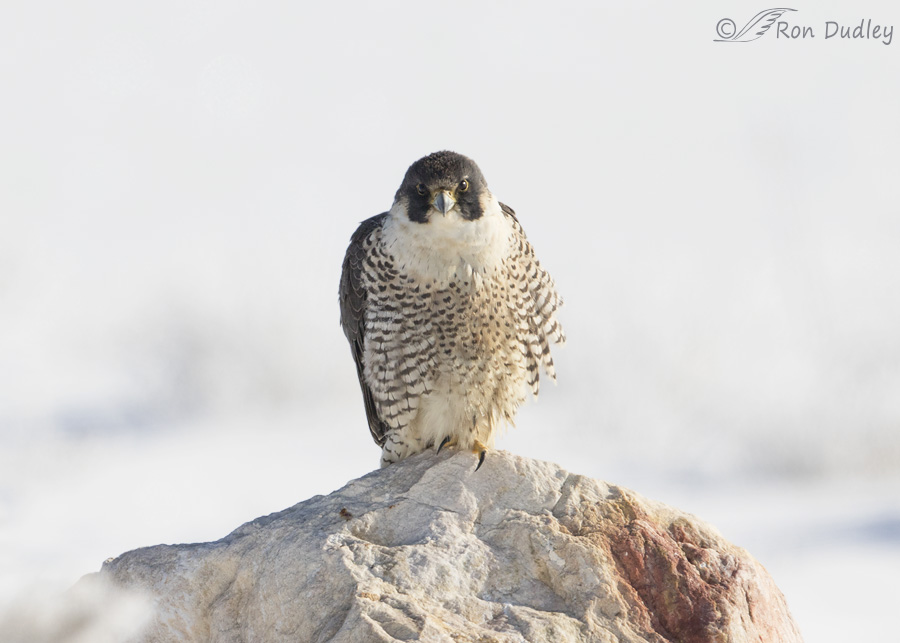
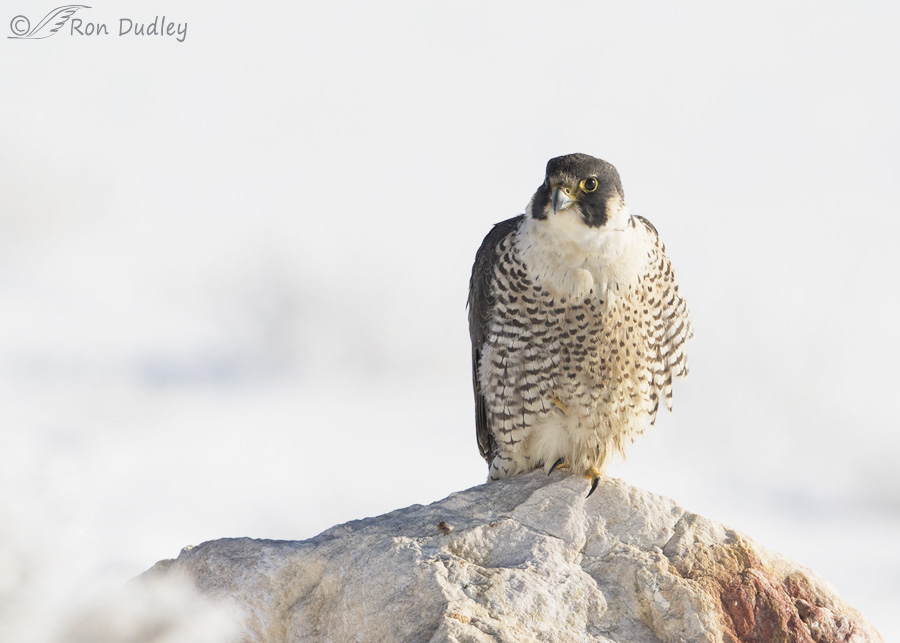
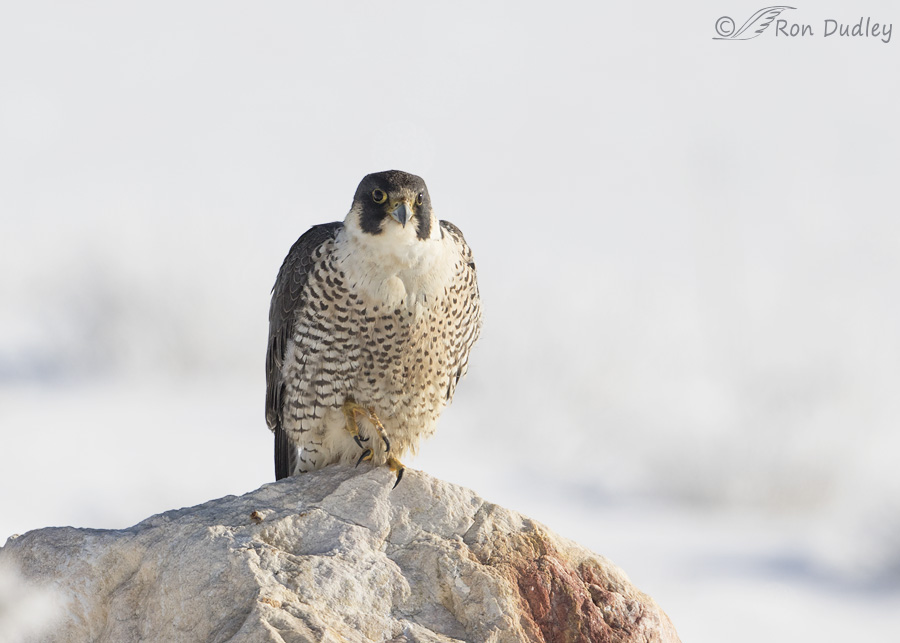
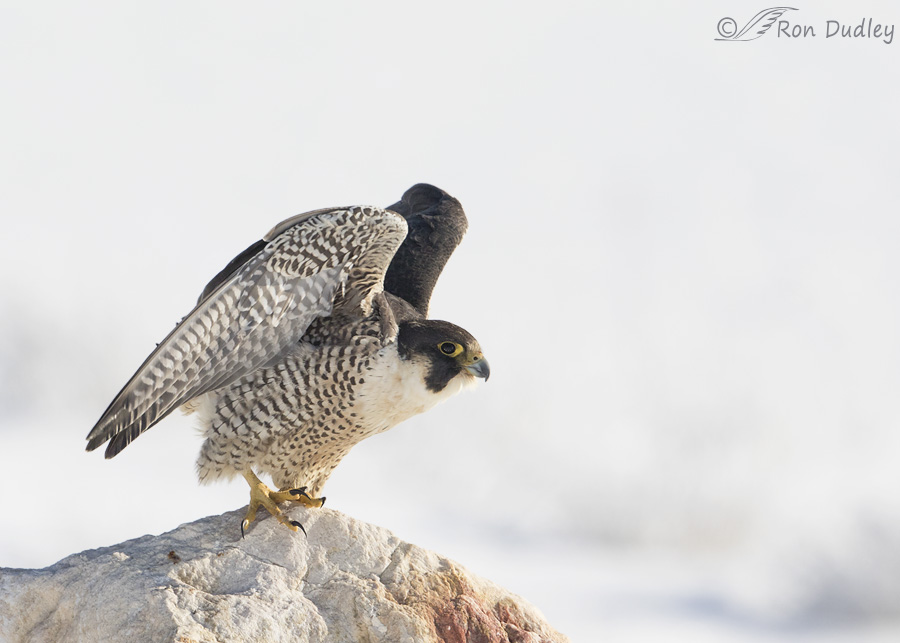
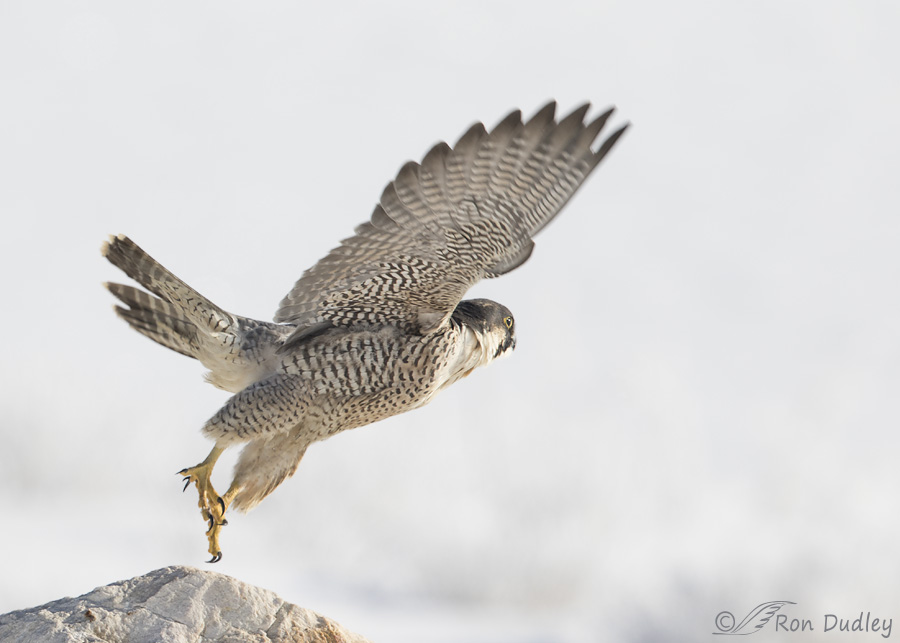
Happened upon your site by chance, beautifyl images and a big hello from rainy England. Kind Regards, Adrian
Thank you, Ron for a stunning series of photos. Why are some members of Congress so insensitive to the need of the more-than-human world to exist freely? Have they never witnessed what you provide for us? Are they so selfish that they would deny to future generations an earth with other living things and with clean air and water. We must support all the environmental groups that we can AND as many legitimate news sources who do serious investigative reporting. Everything is now at stake … and we owe future generations our concerted efforts.
Elizabeth
Late to the party, Ron, after a long day of birding, but WOW! Really beautiful series! A much needed feast for the eyes! Thank you!
Nice sequence Ron. It is really neat to see the time evolution in 1/10 sec increments. You really get a feel for how fast everything happens. I like the light on the falcon, especially the reflected light acting in a way like a fill flash. It is also interesting to see how your shutter speed adapts between shots. I shoot fully manual, however I always think about your high quality images and wonder if I should shoot in aperture priority instead. I will start trying it out in the field. In this sequence all of your shutter speeds were very fast, you had a low ISO and plenty of depth of field at f/8, so really seems to work well. Perhaps since there was plenty of light.
Ed, I’m like you in that when I shoot in bursts (and since I know the burst rate of my camera) I’m often very interested in studying the speed of birds by comparing sequential shots. Along those same lines I also notice that the wing beats of some birds seems to be almost perfectly synchronized to my burst rate. For example, recently I photographed a female Common Merganser who had recently taken off from the water and in about 10 sequential shots her wings were always at the bottom of the downstroke. Pretty interesting I thought.
I stick with aperture priority at least in part because I’m very familiar with its quirks and don’t have to think about it much any more. And I’m a creature of habit…
Hope you’ve made that decision we were talking about last night, one way or the other. 🙂
Sigh.
Love the falcon (how could I not), but some of the comments make my heart ache. Badly.
I know. I know…
Thanks, Charlotte.
Sensational find and series Ron!
Charlotte
Thanks, Charlotte.
Gorgeous bird! He definitely looks cold — and a little irritated — in that first shot. And this is a mighty fine takeoff shot, IMHO.
Thank you, Marty. We were ALL cold!
Beautiful bird. Your faster than me a on the trigger. I usually get butt shots or half a bird. I am good at reading bird body language but not fast enough. I have started filming before I think lift off is going to occur and been able to get some decent shots.
April, I very often begin firing before liftoff – if they even twitch I fire a burst. That means a lot of extra shots to cull but pixels are cheap and I sometimes get lucky!
This is a beautiful series…bird, background and rock. I agree with Rocky about the tske off, “Fling”, shot … my favorite, too….
Thanks very much, Patty.
Great shots as usual Ron. Nice this fellow was so cooperative!
Can’t help when I look at a current picture of a Peregrine Falcon realizing how close they came to becoming extinct here in the US because of DDT. Now we all who love to photograph or just walk in and enjoy nature for natures sake have to look at the GOP making plans to invalidate Endangered Species Act as a natural disaster! I have never said this, but probably will be sorry I did, but I’m old enough to be looking forward to my passing if this country stays on its present course! I just feel for my kids and grandkids and what they will miss and have to endure! My apologies for being dark.
Anyone with even a few fully functional and firing neurons can’t help but feel “dark” these days, Dick – apology unnecessary.
I’m right there with the rest of you…but we need to fight this demonization of being tree huggers! But I’ve had the same thoughts as y’all. Sorry to be late to this party…lovely shots (as usual). I was away at the Arizona Falconer’s Association field meet! Brought home a nasty cold but had a great time 🙂
I feel EXACTLY the same way–for all the same reasons. Something HAS to be done before it’s too late for all of us!!!
You’ve summed it up perfectly, Dick. How can people claim “patriotism” if they seek to destroy the natural beauty of the Earth?
I’ve had thoughts that being on this end of life might not be so bad given the current situation also – try to be hopeful with many starting to step up on many issues………….:)
For what it’s worth, I think the takeoff shot is spectacular. Despite the softness of the wing. I can’t imagine ever being able to get a shot like that. My favorite in this series is the pre-launch shot. I’m also glad that this is a wild bird. Your comment about not having jesses made me start to think about how having jesses on in the wild would make life very difficult for the bird.
That pre-launch photo is probably my favorite too, Susan – despite the “missing” tail.
I once photographed an escaped male kestrel that had illegal “jesses” on that were much too long. That bird continually perched on utility wires where those dangling straps could very easily have become hung up and killed the bird. We reported the falcon and it’s owner eventually captured it again but it wasn’t long before it escaped once more.
Well done, Ron. The rusty colored splotch gives my eye a nice diagonal to work with, and to me, adds to this comp tremendously. Thank goodness for the little things….Beautiful bird under tough conditions; both for you, and him. 🙂
Best…Mitch
I agree about that “rusty splotch” and I think it gives the rock more character and interest. Thanks, Mitch.
I like the image quite a bit, head turned away and all, “a guy going somewhere”. It is seemingly that instant where the bird is not actually flying yet, i.e. no airflow yet over the wings, it has just lept off its perch and spread its wings. And all wingtips are fully in the frame!
“And all wingtips are fully in the frame”
Yup, at least I had that victory, Kelly. It wouldn’t have happened if I hadn’t removed my teleconverter so that part of my strategy did work out. Thanks.
Beautiful sequence of a challenging bird, Ron. Asking for “perfection” with the falcon is asking a lot 🙂 Maybe “next time”……:) The snow did highlight the bird well even if the brightness did create other issues for you.
Thanks, Judy. Snow is often a mixed blessing for the bird photographer, just as it was this time.